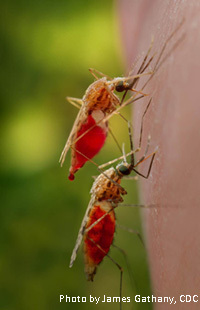
University of Notre Dame researchers played a key role in new studies that provide evidence that Anopheles gambiae, which is one of the major carriers of the malaria parasite in Sub-Saharan Africa, is evolving into two separate species with different traits. The discovery has major implications for malaria control efforts and could eventually lead to new malaria prevention efforts.
According to the World Health Organization, more than 200 million people globally are infected with malaria and the highest rates of the disease are in Sub-Saharan Africa. Malaria kills one child every 30 seconds.
The findings were published in back-to-back articles in today’s (Oct. 22) edition of the journal Science. Nora Besansky, professor of biological sciences, served as senior author of the genome sequencing paper and coordinated the entire sequencing effort, which involved an international consortium of scientists. Scott Emrich, assistant professor of computer science and engineering, was co-lead author of the paper and directed the computational analysis of the sequenced genomes.
The painstaking genomic analysis described in the first paper reveals that Mopti (M) and Savanna (S) varieties of the Anopholes gambiae species, which Besansky describes as physically and developmentally indistinguishable, are evolving into two distinct species.

In the second paper, Besansky and the research team examined many individual mosquitoes from the M and S strains as well as a strain called Bamako and compared 400,000 points in their genomes where genetic variations had been identified, to analyze how the mosquitoes are evolving.
“Our studies basically found that M and S are more isolated genetically than was formerly believed based on less detailed genetic scans, and having the genome sequences in hand will allow us to make more detailed discoveries of the underlying physiological and behavioral differences not apparent to the naked eye,” Besansky said.
Besansky notes that the S strain seems to prefer breeding in temporary pools and puddles, while the M is more adapted to irrigated habitats like rice fields. Puddles attract few predators but evaporate quickly, so S mosquitoes have adapted to grow quickly without natural predators. M mosquitoes, on the other hand, can grow and breed in dry areas, but need to avoid many more predators in more permanent areas.
“Although we knew about these general differences, we still don’t know the detailed biology that explains what changes were necessary for M to adapt to one type of habitat and S to the other,” Besansky said. “We do not know the specific biological differences that explain these observations, but the genome sequence will make this possible.”
The ecological efficiency of Anophels gambiae described in the study helps explain why the species can survive in a variety of environments from humid rainforests to arid savannas.
The research described in the Science papers was supported by the National Institute of Allergy and Infectious Diseases and the National Human Genome Research Institute (NIAID/NHGRI), both components of the National Institutes of Health, the BBSRC, and the Burroughs Wellcome Fund. The studies were collaborations between Notre Dame researchers and international colleagues at the Imperial College London, J.C. Venter Institute, Washington University and the Broad Institute.
Besansky also will be coordinating, and Emrich will play a key role in, the next key step in the sequencing of the Anopheles gambiae genome: analysis of an additional 13 mosquito genomes. The effort, which also is funded by NIAID/NHGRI, will provide important information that will allow researchers to identify and ultimately exploit the key genetic traits that bear on disease transmission.
Contact: Nora Besansky, 574-631-9321, Besansky.1@nd.edu